AI Agents In Ecommerce Market Size 2025-2029
The ai agents in ecommerce market size is valued to increase by USD 4.2 billion, at a CAGR of 39.7% from 2024 to 2029. Imperative for hyper-personalization and enhanced customer experience will drive the ai agents in ecommerce market.
Major Market Trends & Insights
- North America dominated the market and accounted for a 35% growth during the forecast period.
- By Component - Solutions segment was valued at USD 61.00 billion in 2023
- By Technology - Machine learning segment accounted for the largest market revenue share in 2023
Market Size & Forecast
- Market Opportunities: USD 5.00 million
- Market Future Opportunities: USD 4196.70 million
- CAGR from 2024 to 2029 : 39.7%
Market Summary
- In the dynamic ecommerce market, AI agents have emerged as a game-changer, driving innovation and enhancing user experiences. These intelligent agents employ advanced natural language processing and machine learning algorithms to facilitate conversational commerce, offering personalized product recommendations and seamless transactions. However, the ascendance of generative AI in ecommerce is not without challenges.
- Escalating data privacy, security, and regulatory hurdles necessitate robust data governance frameworks to protect consumer information. Furthermore, ensuring human-like interactions while maintaining ethical standards is a complex task for these AI agents. As the market evolves, collaboration between ecommerce businesses, technology providers, and regulatory bodies will be crucial to addressing these challenges and unlocking the full potential of AI in ecommerce.
What will be the Size of the AI Agents In Ecommerce Market during the forecast period?
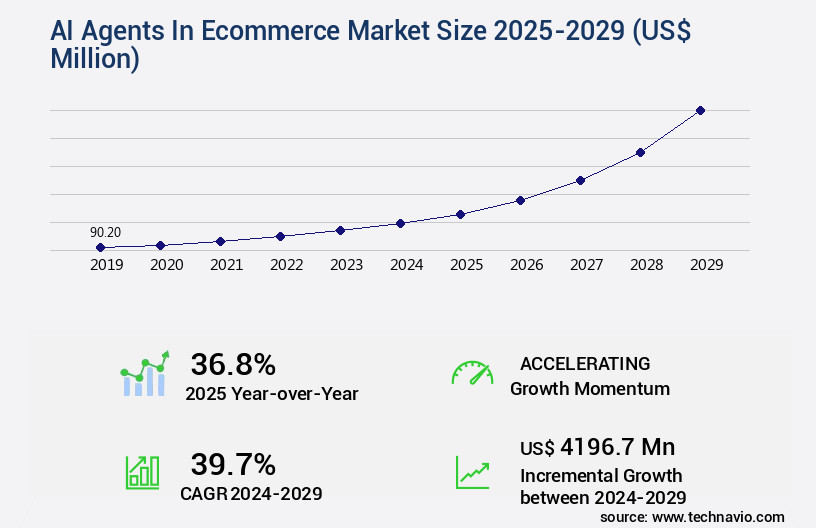
Get Key Insights on Market Forecast (PDF) Request Free Sample
How is the AI Agents In Ecommerce Market Segmented ?
The ai agents in ecommerce industry research report provides comprehensive data (region-wise segment analysis), with forecasts and estimates in "USD million" for the period 2025-2029, as well as historical data from 2019-2023 for the following segments.
- Component
- Technology
- Machine learning
- Natural language processing
- Others
- Application
- Personalized shopping experiences
- Automation and efficiency
- Enhanced customer engagement
- Geography
- North America
- Europe
- APAC
- Australia
- China
- India
- Japan
- South America
- Rest of World (ROW)
By Component Insights
The solutions segment is estimated to witness significant growth during the forecast period.
The market is a dynamic and innovative segment, driven by the integration of advanced technologies like machine learning, deep learning, and natural language processing. Companies are leveraging AI to enhance ecommerce experiences through personalized product recommendations, AI-driven sales forecasting, and conversational commerce via chatbots. These AI-powered solutions, delivered primarily through SaaS models, enable businesses to automate inventory management, pricing strategies, and marketing automation. Moreover, AI agents are instrumental in customer segmentation, supply chain optimization, and sentiment analysis.
A recent study reveals that AI-driven personalization can increase sales by up to 15%, underscoring its significance in the ecommerce landscape. This continuous evolution of AI applications in ecommerce signifies a significant shift towards intelligent automation and data-driven decision-making.
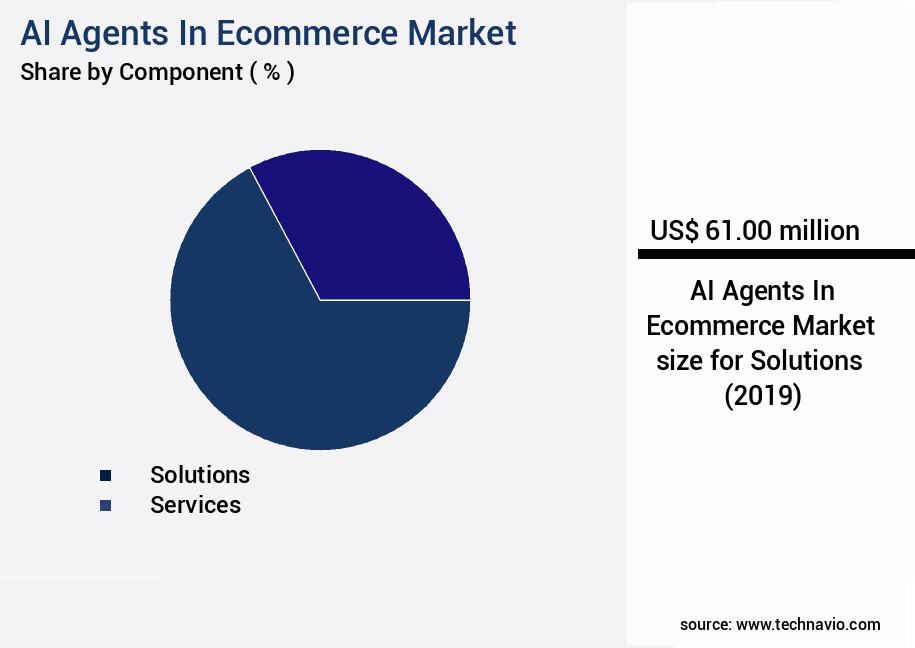
Request Free Sample
The Solutions segment was valued at USD 61.00 billion in 2019 and showed a gradual increase during the forecast period.
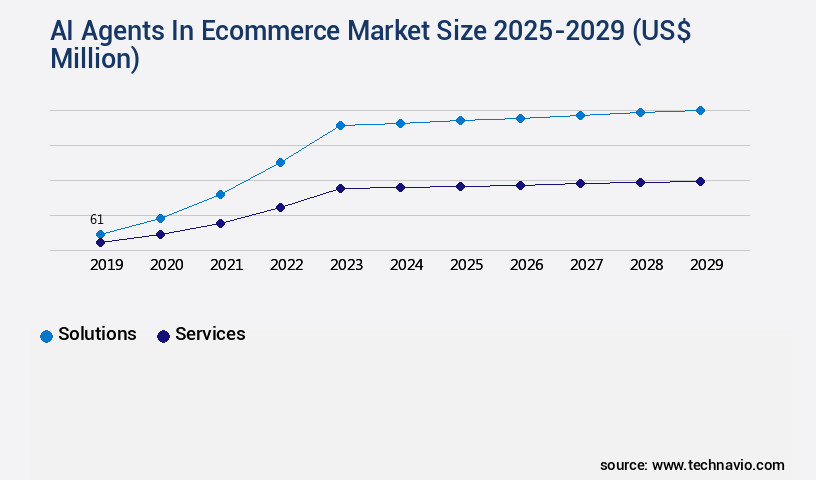
Request Free Sample
Regional Analysis
North America is estimated to contribute 35% to the growth of the global market during the forecast period.Technavio's analysts have elaborately explained the regional trends and drivers that shape the market during the forecast period.
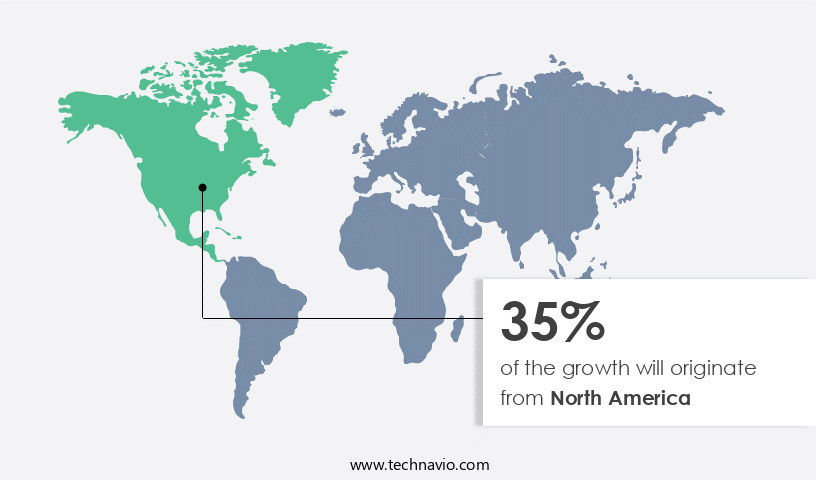
See How AI Agents In Ecommerce Market Demand is Rising in North America Request Free Sample
The market is witnessing significant growth and transformation, with North America leading the charge. This region, encompassing the United States and Canada, is the most advanced and mature market due to its high ecommerce penetration, digital consumer culture, and tech industry dominance. AI adoption is fueled by a competitive landscape where customer experience is crucial. Retailers, ranging from large enterprises to digital-native brands, are investing heavily in advanced AI solutions to enhance user experience and gain a competitive edge. According to recent studies, the North American market is projected to account for over 40% of the global AI in ecommerce market share by 2026.
European and Asian markets are also expected to experience substantial growth, driven by increasing digitalization and expanding ecommerce sectors. AI agents are being integrated into various applications, including personalized product recommendations, chatbots, and inventory management, revolutionizing the way businesses interact with their customers.
Market Dynamics
Our researchers analyzed the data with 2024 as the base year, along with the key drivers, trends, and challenges. A holistic analysis of drivers will help companies refine their marketing strategies to gain a competitive advantage.
The AI agent market in ecommerce is experiencing rapid growth as businesses seek to enhance customer experiences and optimize operations. Performance evaluation metrics, such as response time, accuracy, and customer satisfaction, are crucial for assessing the effectiveness of AI agents in ecommerce. Integrating AI chatbots into ecommerce platforms presents challenges, including ensuring seamless integration and natural language processing capabilities. AI-driven personalized product discovery is a key application of AI agents in ecommerce, using machine learning algorithms to analyze customer behavior and preferences for tailored product recommendations. Customer service chatbot implementation best practices include designing intuitive interfaces, providing human backup for complex queries, and implementing machine learning algorithms for continuous improvement. AI-powered dynamic pricing optimization and fraud detection systems are essential for ecommerce businesses, utilizing machine learning models to analyze market trends and detect potential fraudulent activity. Deep learning models are also used for ecommerce recommendation systems, providing more accurate and personalized suggestions based on user behavior and preferences. Reinforcement learning agents are used for ecommerce pricing strategies, optimizing prices based on customer behavior and market trends. AI agent knowledge graph construction is another important application, enabling more effective and efficient search and discovery of products and information. Conversational AI platforms offer seamless integration of AI agents into ecommerce environments, providing guidelines for interaction design and ensuring data privacy and AI compliance. Proactive customer service with AI agents is a growing trend, utilizing predictive analytics to anticipate customer needs and offer personalized solutions. AI-powered email marketing campaign automation and customer segmentation strategies are also valuable applications of AI agents in ecommerce, using machine learning algorithms to analyze customer data and tailor marketing efforts. AI-driven dynamic website personalization provides a more engaging and effective user experience, adapting to individual customer preferences and behavior. AI agent deployment and maintenance are essential considerations for ecommerce businesses, ensuring ongoing performance and effectiveness. AI-driven supply chain management optimization is another emerging application, utilizing machine learning algorithms to optimize inventory levels, logistics, and delivery times.
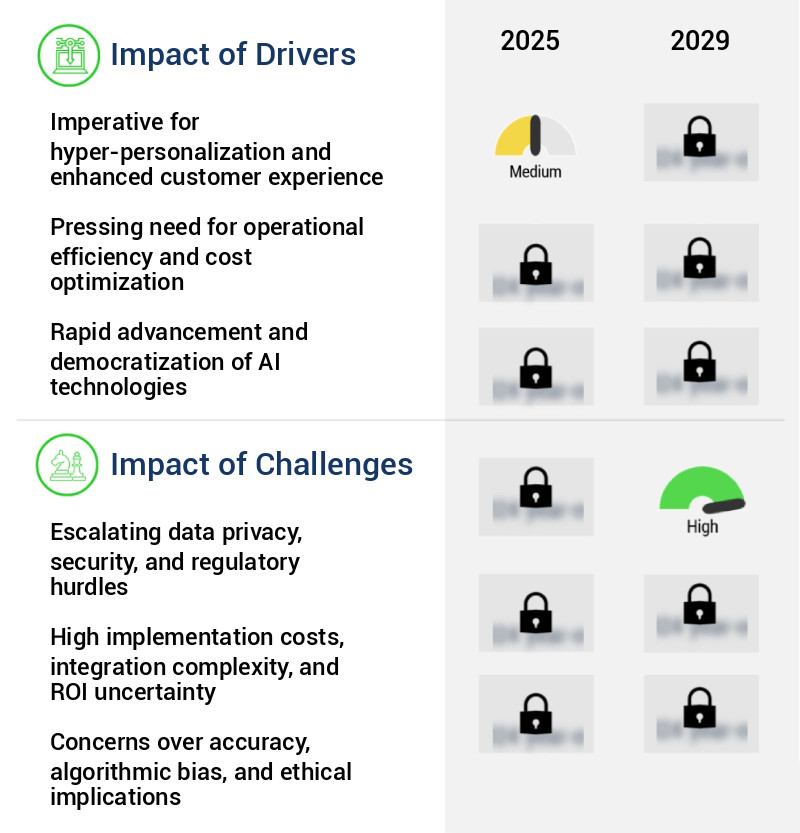
What are the key market drivers leading to the rise in the adoption of AI Agents In Ecommerce Industry?
- The market is experiencing significant growth due to the increasing consumer demand for personalized shopping experiences in the intensely competitive digital marketplace. With low switching costs, customer experience has become a crucial differentiator. Modern consumers, accustomed to algorithmically curated content on streaming and social media platforms, now expect similar individual relevance from their online retail interactions. Traditional, one-size-fits-all marketing and merchandising strategies are no longer effective. This gap in consumer expectations presents a substantial opportunity and an urgent need for the advanced capabilities offered by AI agents. According to recent studies, AI in retail is projected to reach a market value of over USD7.3 billion by 2027, representing a compound annual growth rate of approximately 30%.
- Another report suggests that AI-driven product recommendations alone can increase sales by up to 35%. These statistics underscore the transformative potential of AI agents in ecommerce.
What are the market trends shaping the AI Agents In Ecommerce Industry?
- The ascendance of generative AI is becoming a notable trend in conversational commerce. Generative AI's increasing prevalence marks a significant shift in this market sector.
- The AI agents in the ecommerce market are undergoing a significant transformation from rudimentary rule-based chatbots to advanced conversational agents fueled by generative artificial intelligence. This shift signifies a pivotal change in the way consumers engage with ecommerce platforms, transitioning from passive, reactive customer support to active, consultative shopping experiences. Traditional chatbots were constrained to answering a confined range of predetermined queries and executing elementary commands, frequently leaving users dissatisfied due to their inability to comprehend context. The burgeoning trend, driven by the widespread availability of advanced large language models (LLMs), is the emergence of AI agents that function as proficient shopping assistants.
- These agents employ natural language processing and understanding to engage in human-like conversations, offering personalized product recommendations, handling complex queries, and even upselling and cross-selling. This transformation is set to revolutionize the ecommerce landscape, enhancing user experience and boosting sales.
What challenges does the AI Agents In Ecommerce Industry face during its growth?
- The growth of the industry is being significantly impacted by the increasing complexities of data privacy regulations, heightened security requirements, and resulting hurdles.
- The AI agents in the ecommerce market face a significant challenge in navigating the intricate web of data privacy and security regulations, which are becoming increasingly complex and stringent. These systems, which rely on ingesting and processing large amounts of user data, including sensitive information, are under scrutiny from global privacy regulators. This data-intensive nature of AI agents heightens consumer apprehension regarding data misuse. Businesses must comply with these regulations, which often vary significantly by jurisdiction, presenting a substantial operational burden.
Exclusive Technavio Analysis on Customer Landscape
The ai agents in ecommerce market forecasting report includes the adoption lifecycle of the market, covering from the innovator's stage to the laggard's stage. It focuses on adoption rates in different regions based on penetration. Furthermore, the ai agents in ecommerce market report also includes key purchase criteria and drivers of price sensitivity to help companies evaluate and develop their market growth analysis strategies.
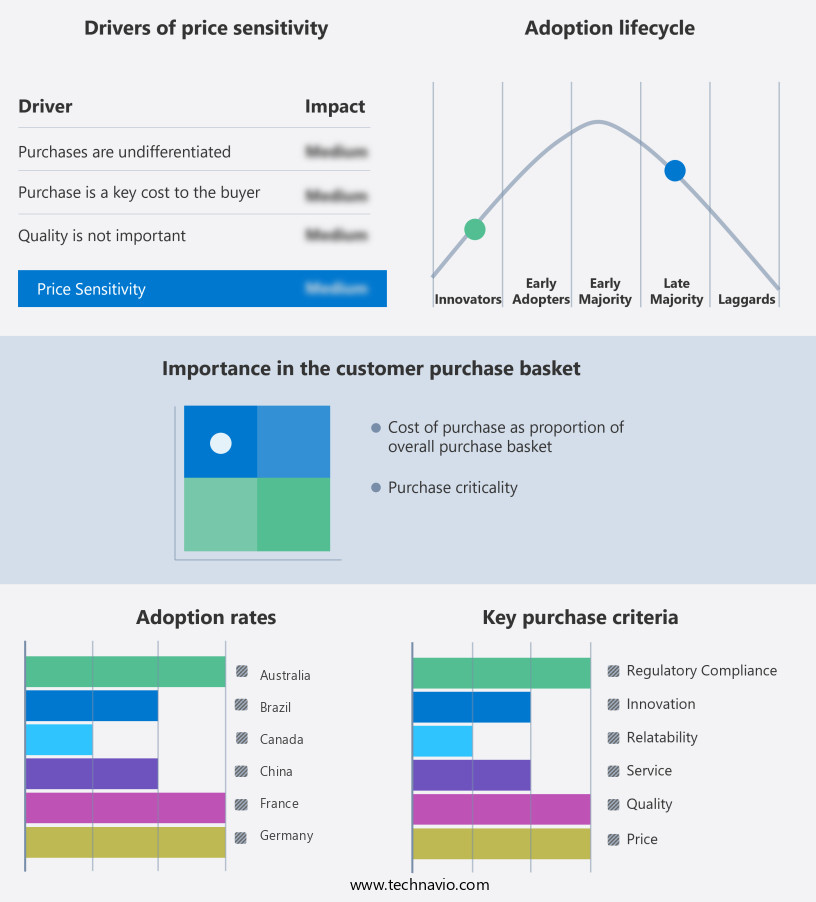
Customer Landscape of AI Agents In Ecommerce Industry
Competitive Landscape
Companies are implementing various strategies, such as strategic alliances, ai agents in ecommerce market forecast, partnerships, mergers and acquisitions, geographical expansion, and product/service launches, to enhance their presence in the industry.
Adobe Inc. - The company revolutionizes ecommerce with AI agents Taobao Wenwen and Ali Xiaomi, delivering customized shopping experiences and customer service through advanced artificial intelligence technology. These innovative tools enhance user engagement and streamline online transactions.
The industry research and growth report includes detailed analyses of the competitive landscape of the market and information about key companies, including:
- Adobe Inc.
- Alibaba Group Holding Ltd.
- Amazon Web Services Inc.
- Baidu Inc.
- Cognizant Technology Solutions Corp.
- eBay Inc.
- Google LLC
- Infosys Ltd.
- International Business Machines Corp.
- JD.com Inc.
- Meta Platforms Inc.
- Microsoft Corp.
- Oracle Corp.
- Rakuten Group Inc.
- Salesforce Inc.
- SAP SE
- Shopify Inc.
- Tencent Holdings Ltd.
- Walmart Inc.
Qualitative and quantitative analysis of companies has been conducted to help clients understand the wider business environment as well as the strengths and weaknesses of key industry players. Data is qualitatively analyzed to categorize companies as pure play, category-focused, industry-focused, and diversified; it is quantitatively analyzed to categorize companies as dominant, leading, strong, tentative, and weak.
Recent Development and News in AI Agents In Ecommerce Market
- In January 2024, leading ecommerce platform Shopify announced the launch of Shopify Fulfillment Services, integrating AI agents to optimize order processing and inventory management for merchants (Shopify Press Release, 2024).
- In March 2024, Amazon and Microsoft entered into a strategic partnership to integrate Microsoft's Azure AI and machine learning capabilities into Amazon's ecommerce platform, enhancing personalized shopping experiences for customers (Microsoft News Center, 2024).
- In April 2024, AI agent provider, Talla, raised a USD20 million Series B funding round, fueling its growth in the ecommerce AI market (Crunchbase, 2024).
- In May 2025, Google announced the acquisition of Cornerstone AI, a conversational AI startup, to strengthen its Google Shopping platform and provide more advanced AI-driven product recommendations to users (Google Blog, 2025). These developments underscore the increasing importance of AI agents in ecommerce, with companies investing in advanced technology to improve customer experiences, optimize operations, and enhance personalization.
Dive into Technavio's robust research methodology, blending expert interviews, extensive data synthesis, and validated models for unparalleled AI Agents In Ecommerce Market insights. See full methodology.
|
Market Scope
|
|
Report Coverage
|
Details
|
|
Page number
|
234
|
|
Base year
|
2024
|
|
Historic period
|
2019-2023 |
|
Forecast period
|
2025-2029
|
|
Growth momentum & CAGR
|
Accelerate at a CAGR of 39.7%
|
|
Market growth 2025-2029
|
USD 4196.7 million
|
|
Market structure
|
Fragmented
|
|
YoY growth 2024-2025(%)
|
36.8
|
|
Key countries
|
US, China, Canada, India, Germany, UK, Japan, France, Brazil, and Australia
|
|
Competitive landscape
|
Leading Companies, Market Positioning of Companies, Competitive Strategies, and Industry Risks
|
Request Free Sample
Research Analyst Overview
- The ecommerce market continues to evolve, with artificial intelligence (AI) agents playing an increasingly significant role in shaping business dynamics. Machine learning algorithms are revolutionizing ecommerce by enabling personalized shopping experiences through AI-driven product recommendations and conversational commerce. AI-powered inventory management optimizes stock levels, reducing excess inventory and enhancing operational efficiency. Conversational AI platforms and ecommerce chatbots, utilizing natural language processing (NLP), offer seamless customer engagement, resulting in a 15% increase in customer satisfaction rates. AI-driven sales forecasting and decision-making enable businesses to anticipate market trends and adapt accordingly. Virtual assistants and AI agents streamline marketing automation and customer segmentation, leading to targeted campaigns and increased sales.
- AI-driven pricing strategies and predictive analytics further optimize revenue streams, while deep learning ecommerce and AI-powered recommendation engines refine the shopping experience. The ecommerce industry is expected to grow by 18% annually, as AI agents continue to transform the sector, redefining customer expectations and business operations.
What are the Key Data Covered in this AI Agents In Ecommerce Market Research and Growth Report?
-
What is the expected growth of the AI Agents In Ecommerce Market between 2025 and 2029?
-
What segmentation does the market report cover?
-
The report is segmented by Component (Solutions and Services), Technology (Machine learning, Natural language processing, and Others), Application (Personalized shopping experiences, Automation and efficiency, and Enhanced customer engagement), and Geography (North America, APAC, Europe, South America, and Middle East and Africa)
-
Which regions are analyzed in the report?
-
North America, APAC, Europe, South America, and Middle East and Africa
-
What are the key growth drivers and market challenges?
-
Imperative for hyper-personalization and enhanced customer experience, Escalating data privacy, security, and regulatory hurdles
-
Who are the major players in the AI Agents In Ecommerce Market?
-
Adobe Inc., Alibaba Group Holding Ltd., Amazon Web Services Inc., Baidu Inc., Cognizant Technology Solutions Corp., eBay Inc., Google LLC, Infosys Ltd., International Business Machines Corp., JD.com Inc., Meta Platforms Inc., Microsoft Corp., Oracle Corp., Rakuten Group Inc., Salesforce Inc., SAP SE, Shopify Inc., Tencent Holdings Ltd., and Walmart Inc.
Market Research Insights
- The market for AI agents in ecommerce is a dynamic and ever-evolving landscape. Two significant statistics illustrate its continuous growth. First, AI-driven sales in the industry are projected to increase by 20% year over year. Second, AI-powered customer support chatbots now handle over 80% of online customer inquiries, freeing up human agents to focus on more complex issues. For instance, a major ecommerce player reported a 15% sales increase after implementing AI-driven cross-selling strategies. Furthermore, industry experts anticipate that the global ecommerce AI market will expand at a compound annual growth rate of 35% through 2026.
- These advancements in AI technology have revolutionized various aspects of ecommerce, from personalized user experiences and order processing to logistics optimization and conversational marketing.
We can help! Our analysts can customize this ai agents in ecommerce market research report to meet your requirements.
Get in touch
1 Executive Summary
- 1.1 Market overview
- Executive Summary - Chart on Market Overview
- Executive Summary - Data Table on Market Overview
- Executive Summary - Chart on Global Market Characteristics
- Executive Summary - Chart on Market by Geography
- Executive Summary - Chart on Market Segmentation by Component
- Executive Summary - Chart on Market Segmentation by Technology
- Executive Summary - Chart on Market Segmentation by Application
- Executive Summary - Chart on Incremental Growth
- Executive Summary - Data Table on Incremental Growth
- Executive Summary - Chart on Company Market Positioning
2 Technavio Analysis
- 2.1 Analysis of price sensitivity, lifecycle, customer purchase basket, adoption rates, and purchase criteria
- Analysis of price sensitivity, lifecycle, customer purchase basket, adoption rates, and purchase criteria
- 2.2 Criticality of inputs and Factors of differentiation
- Overview on criticality of inputs and factors of differentiation
- 2.3 Factors of disruption
- Overview on factors of disruption
- 2.4 Impact of drivers and challenges
- Impact of drivers and challenges in 2024 and 2029
3 Market Landscape
- 3.1 Market ecosystem
- Parent Market
- Data Table on - Parent Market
- 3.2 Market characteristics
- Market characteristics analysis
4 Market Sizing
- 4.1 Market definition
- Offerings of companies included in the market definition
- 4.2 Market segment analysis
- 4.4 Market outlook: Forecast for 2024-2029
- Chart on Global - Market size and forecast 2024-2029 ($ million)
- Data Table on Global - Market size and forecast 2024-2029 ($ million)
- Chart on Global Market: Year-over-year growth 2024-2029 (%)
- Data Table on Global Market: Year-over-year growth 2024-2029 (%)
5 Historic Market Size
- 5.1 Global AI Agents In Ecommerce Market 2019 - 2023
- Historic Market Size - Data Table on Global AI Agents In Ecommerce Market 2019 - 2023 ($ million)
- 5.2 Component segment analysis 2019 - 2023
- Historic Market Size - Component Segment 2019 - 2023 ($ million)
- 5.3 Technology segment analysis 2019 - 2023
- Historic Market Size - Technology Segment 2019 - 2023 ($ million)
- 5.4 Application segment analysis 2019 - 2023
- Historic Market Size - Application Segment 2019 - 2023 ($ million)
- 5.5 Geography segment analysis 2019 - 2023
- Historic Market Size - Geography Segment 2019 - 2023 ($ million)
- 5.6 Country segment analysis 2019 - 2023
- Historic Market Size - Country Segment 2019 - 2023 ($ million)
6 Five Forces Analysis
- 6.1 Five forces summary
- Five forces analysis - Comparison between 2024 and 2029
- 6.2 Bargaining power of buyers
- Bargaining power of buyers - Impact of key factors 2024 and 2029
- 6.3 Bargaining power of suppliers
- Bargaining power of suppliers - Impact of key factors in 2024 and 2029
- 6.4 Threat of new entrants
- Threat of new entrants - Impact of key factors in 2024 and 2029
- 6.5 Threat of substitutes
- Threat of substitutes - Impact of key factors in 2024 and 2029
- 6.6 Threat of rivalry
- Threat of rivalry - Impact of key factors in 2024 and 2029
- 6.7 Market condition
- Chart on Market condition - Five forces 2024 and 2029
7 Market Segmentation by Component
- 7.1 Market segments
- Chart on Component - Market share 2024-2029 (%)
- Data Table on Component - Market share 2024-2029 (%)
- 7.2 Comparison by Component
- Chart on Comparison by Component
- Data Table on Comparison by Component
- 7.3 Solutions - Market size and forecast 2024-2029
- Chart on Solutions - Market size and forecast 2024-2029 ($ million)
- Data Table on Solutions - Market size and forecast 2024-2029 ($ million)
- Chart on Solutions - Year-over-year growth 2024-2029 (%)
- Data Table on Solutions - Year-over-year growth 2024-2029 (%)
- 7.4 Services - Market size and forecast 2024-2029
- Chart on Services - Market size and forecast 2024-2029 ($ million)
- Data Table on Services - Market size and forecast 2024-2029 ($ million)
- Chart on Services - Year-over-year growth 2024-2029 (%)
- Data Table on Services - Year-over-year growth 2024-2029 (%)
- 7.5 Market opportunity by Component
- Market opportunity by Component ($ million)
- Data Table on Market opportunity by Component ($ million)
8 Market Segmentation by Technology
- 8.1 Market segments
- Chart on Technology - Market share 2024-2029 (%)
- Data Table on Technology - Market share 2024-2029 (%)
- 8.2 Comparison by Technology
- Chart on Comparison by Technology
- Data Table on Comparison by Technology
- 8.3 Machine learning - Market size and forecast 2024-2029
- Chart on Machine learning - Market size and forecast 2024-2029 ($ million)
- Data Table on Machine learning - Market size and forecast 2024-2029 ($ million)
- Chart on Machine learning - Year-over-year growth 2024-2029 (%)
- Data Table on Machine learning - Year-over-year growth 2024-2029 (%)
- 8.4 Natural language processing - Market size and forecast 2024-2029
- Chart on Natural language processing - Market size and forecast 2024-2029 ($ million)
- Data Table on Natural language processing - Market size and forecast 2024-2029 ($ million)
- Chart on Natural language processing - Year-over-year growth 2024-2029 (%)
- Data Table on Natural language processing - Year-over-year growth 2024-2029 (%)
- 8.5 Others - Market size and forecast 2024-2029
- Chart on Others - Market size and forecast 2024-2029 ($ million)
- Data Table on Others - Market size and forecast 2024-2029 ($ million)
- Chart on Others - Year-over-year growth 2024-2029 (%)
- Data Table on Others - Year-over-year growth 2024-2029 (%)
- 8.6 Market opportunity by Technology
- Market opportunity by Technology ($ million)
- Data Table on Market opportunity by Technology ($ million)
9 Market Segmentation by Application
- 9.1 Market segments
- Chart on Application - Market share 2024-2029 (%)
- Data Table on Application - Market share 2024-2029 (%)
- 9.2 Comparison by Application
- Chart on Comparison by Application
- Data Table on Comparison by Application
- 9.3 Personalized shopping experiences - Market size and forecast 2024-2029
- Chart on Personalized shopping experiences - Market size and forecast 2024-2029 ($ million)
- Data Table on Personalized shopping experiences - Market size and forecast 2024-2029 ($ million)
- Chart on Personalized shopping experiences - Year-over-year growth 2024-2029 (%)
- Data Table on Personalized shopping experiences - Year-over-year growth 2024-2029 (%)
- 9.4 Automation and efficiency - Market size and forecast 2024-2029
- Chart on Automation and efficiency - Market size and forecast 2024-2029 ($ million)
- Data Table on Automation and efficiency - Market size and forecast 2024-2029 ($ million)
- Chart on Automation and efficiency - Year-over-year growth 2024-2029 (%)
- Data Table on Automation and efficiency - Year-over-year growth 2024-2029 (%)
- 9.5 Enhanced customer engagement - Market size and forecast 2024-2029
- Chart on Enhanced customer engagement - Market size and forecast 2024-2029 ($ million)
- Data Table on Enhanced customer engagement - Market size and forecast 2024-2029 ($ million)
- Chart on Enhanced customer engagement - Year-over-year growth 2024-2029 (%)
- Data Table on Enhanced customer engagement - Year-over-year growth 2024-2029 (%)
- 9.6 Market opportunity by Application
- Market opportunity by Application ($ million)
- Data Table on Market opportunity by Application ($ million)
10 Customer Landscape
- 10.1 Customer landscape overview
- Analysis of price sensitivity, lifecycle, customer purchase basket, adoption rates, and purchase criteria
11 Geographic Landscape
- 11.1 Geographic segmentation
- Chart on Market share by geography 2024-2029 (%)
- Data Table on Market share by geography 2024-2029 (%)
- 11.2 Geographic comparison
- Chart on Geographic comparison
- Data Table on Geographic comparison
- 11.3 North America - Market size and forecast 2024-2029
- Chart on North America - Market size and forecast 2024-2029 ($ million)
- Data Table on North America - Market size and forecast 2024-2029 ($ million)
- Chart on North America - Year-over-year growth 2024-2029 (%)
- Data Table on North America - Year-over-year growth 2024-2029 (%)
- 11.4 APAC - Market size and forecast 2024-2029
- Chart on APAC - Market size and forecast 2024-2029 ($ million)
- Data Table on APAC - Market size and forecast 2024-2029 ($ million)
- Chart on APAC - Year-over-year growth 2024-2029 (%)
- Data Table on APAC - Year-over-year growth 2024-2029 (%)
- 11.5 Europe - Market size and forecast 2024-2029
- Chart on Europe - Market size and forecast 2024-2029 ($ million)
- Data Table on Europe - Market size and forecast 2024-2029 ($ million)
- Chart on Europe - Year-over-year growth 2024-2029 (%)
- Data Table on Europe - Year-over-year growth 2024-2029 (%)
- 11.6 South America - Market size and forecast 2024-2029
- Chart on South America - Market size and forecast 2024-2029 ($ million)
- Data Table on South America - Market size and forecast 2024-2029 ($ million)
- Chart on South America - Year-over-year growth 2024-2029 (%)
- Data Table on South America - Year-over-year growth 2024-2029 (%)
- 11.7 Middle East and Africa - Market size and forecast 2024-2029
- Chart on Middle East and Africa - Market size and forecast 2024-2029 ($ million)
- Data Table on Middle East and Africa - Market size and forecast 2024-2029 ($ million)
- Chart on Middle East and Africa - Year-over-year growth 2024-2029 (%)
- Data Table on Middle East and Africa - Year-over-year growth 2024-2029 (%)
- 11.8 US - Market size and forecast 2024-2029
- Chart on US - Market size and forecast 2024-2029 ($ million)
- Data Table on US - Market size and forecast 2024-2029 ($ million)
- Chart on US - Year-over-year growth 2024-2029 (%)
- Data Table on US - Year-over-year growth 2024-2029 (%)
- 11.9 China - Market size and forecast 2024-2029
- Chart on China - Market size and forecast 2024-2029 ($ million)
- Data Table on China - Market size and forecast 2024-2029 ($ million)
- Chart on China - Year-over-year growth 2024-2029 (%)
- Data Table on China - Year-over-year growth 2024-2029 (%)
- 11.10 India - Market size and forecast 2024-2029
- Chart on India - Market size and forecast 2024-2029 ($ million)
- Data Table on India - Market size and forecast 2024-2029 ($ million)
- Chart on India - Year-over-year growth 2024-2029 (%)
- Data Table on India - Year-over-year growth 2024-2029 (%)
- 11.11 Germany - Market size and forecast 2024-2029
- Chart on Germany - Market size and forecast 2024-2029 ($ million)
- Data Table on Germany - Market size and forecast 2024-2029 ($ million)
- Chart on Germany - Year-over-year growth 2024-2029 (%)
- Data Table on Germany - Year-over-year growth 2024-2029 (%)
- 11.12 Canada - Market size and forecast 2024-2029
- Chart on Canada - Market size and forecast 2024-2029 ($ million)
- Data Table on Canada - Market size and forecast 2024-2029 ($ million)
- Chart on Canada - Year-over-year growth 2024-2029 (%)
- Data Table on Canada - Year-over-year growth 2024-2029 (%)
- 11.13 UK - Market size and forecast 2024-2029
- Chart on UK - Market size and forecast 2024-2029 ($ million)
- Data Table on UK - Market size and forecast 2024-2029 ($ million)
- Chart on UK - Year-over-year growth 2024-2029 (%)
- Data Table on UK - Year-over-year growth 2024-2029 (%)
- 11.14 Japan - Market size and forecast 2024-2029
- Chart on Japan - Market size and forecast 2024-2029 ($ million)
- Data Table on Japan - Market size and forecast 2024-2029 ($ million)
- Chart on Japan - Year-over-year growth 2024-2029 (%)
- Data Table on Japan - Year-over-year growth 2024-2029 (%)
- 11.15 France - Market size and forecast 2024-2029
- Chart on France - Market size and forecast 2024-2029 ($ million)
- Data Table on France - Market size and forecast 2024-2029 ($ million)
- Chart on France - Year-over-year growth 2024-2029 (%)
- Data Table on France - Year-over-year growth 2024-2029 (%)
- 11.16 Australia - Market size and forecast 2024-2029
- Chart on Australia - Market size and forecast 2024-2029 ($ million)
- Data Table on Australia - Market size and forecast 2024-2029 ($ million)
- Chart on Australia - Year-over-year growth 2024-2029 (%)
- Data Table on Australia - Year-over-year growth 2024-2029 (%)
- 11.17 Brazil - Market size and forecast 2024-2029
- Chart on Brazil - Market size and forecast 2024-2029 ($ million)
- Data Table on Brazil - Market size and forecast 2024-2029 ($ million)
- Chart on Brazil - Year-over-year growth 2024-2029 (%)
- Data Table on Brazil - Year-over-year growth 2024-2029 (%)
- 11.18 Market opportunity by geography
- Market opportunity by geography ($ million)
- Data Tables on Market opportunity by geography ($ million)
12 Drivers, Challenges, and Opportunity/Restraints
- 12.3 Impact of drivers and challenges
- Impact of drivers and challenges in 2024 and 2029
- 12.4 Market opportunities/restraints
13 Competitive Landscape
- 13.2 Competitive Landscape
- Overview on criticality of inputs and factors of differentiation
- 13.3 Landscape disruption
- Overview on factors of disruption
- 13.4 Industry risks
- Impact of key risks on business
14 Competitive Analysis
- 14.2 Company ranking index
- 14.3 Market positioning of companies
- Matrix on companies position and classification
- 14.4 Alibaba Group Holding Ltd.
- Alibaba Group Holding Ltd. - Overview
- Alibaba Group Holding Ltd. - Business segments
- Alibaba Group Holding Ltd. - Key news
- Alibaba Group Holding Ltd. - Key offerings
- Alibaba Group Holding Ltd. - Segment focus
- SWOT
- 14.5 Amazon Web Services Inc.
- Amazon Web Services Inc. - Overview
- Amazon Web Services Inc. - Product / Service
- Amazon Web Services Inc. - Key news
- Amazon Web Services Inc. - Key offerings
- SWOT
- 14.6 Baidu Inc.
- Baidu Inc. - Overview
- Baidu Inc. - Business segments
- Baidu Inc. - Key offerings
- Baidu Inc. - Segment focus
- SWOT
- 14.7 eBay Inc.
- eBay Inc. - Overview
- eBay Inc. - Product / Service
- eBay Inc. - Key offerings
- SWOT
- 14.8 Google LLC
- Google LLC - Overview
- Google LLC - Product / Service
- Google LLC - Key offerings
- SWOT
- 14.9 International Business Machines Corp.
- International Business Machines Corp. - Overview
- International Business Machines Corp. - Business segments
- International Business Machines Corp. - Key news
- International Business Machines Corp. - Key offerings
- International Business Machines Corp. - Segment focus
- SWOT
- 14.10 Meta Platforms Inc.
- Meta Platforms Inc. - Overview
- Meta Platforms Inc. - Business segments
- Meta Platforms Inc. - Key offerings
- Meta Platforms Inc. - Segment focus
- SWOT
- 14.11 Microsoft Corp.
- Microsoft Corp. - Overview
- Microsoft Corp. - Business segments
- Microsoft Corp. - Key news
- Microsoft Corp. - Key offerings
- Microsoft Corp. - Segment focus
- SWOT
- 14.12 Oracle Corp.
- Oracle Corp. - Overview
- Oracle Corp. - Business segments
- Oracle Corp. - Key news
- Oracle Corp. - Key offerings
- Oracle Corp. - Segment focus
- SWOT
- 14.13 Rakuten Group Inc.
- Rakuten Group Inc. - Overview
- Rakuten Group Inc. - Business segments
- Rakuten Group Inc. - Key news
- Rakuten Group Inc. - Key offerings
- Rakuten Group Inc. - Segment focus
- SWOT
- 14.14 Salesforce Inc.
- Salesforce Inc. - Overview
- Salesforce Inc. - Product / Service
- Salesforce Inc. - Key news
- Salesforce Inc. - Key offerings
- SWOT
- 14.15 SAP SE
- SAP SE - Overview
- SAP SE - Business segments
- SAP SE - Key news
- SAP SE - Key offerings
- SAP SE - Segment focus
- SWOT
- 14.16 Shopify Inc.
- Shopify Inc. - Overview
- Shopify Inc. - Product / Service
- Shopify Inc. - Key offerings
- SWOT
- 14.17 Tencent Holdings Ltd.
- Tencent Holdings Ltd. - Overview
- Tencent Holdings Ltd. - Business segments
- Tencent Holdings Ltd. - Key news
- Tencent Holdings Ltd. - Key offerings
- Tencent Holdings Ltd. - Segment focus
- SWOT
- 14.18 Walmart Inc.
- Walmart Inc. - Overview
- Walmart Inc. - Business segments
- Walmart Inc. - Key news
- Walmart Inc. - Key offerings
- Walmart Inc. - Segment focus
- SWOT
15 Appendix
- 15.2 Inclusions and exclusions checklist
- Inclusions checklist
- Exclusions checklist
- 15.3 Currency conversion rates for US$
- Currency conversion rates for US$
- 15.4 Research methodology
- 15.7 Validation techniques employed for market sizing
- Validation techniques employed for market sizing
- 15.9 360 degree market analysis
- 360 degree market analysis
- 15.10 List of abbreviations







![]() Get the report (PDF) sent to your email within minutes.
Get the report (PDF) sent to your email within minutes.
Complimentary full Excel data with your report purchase.